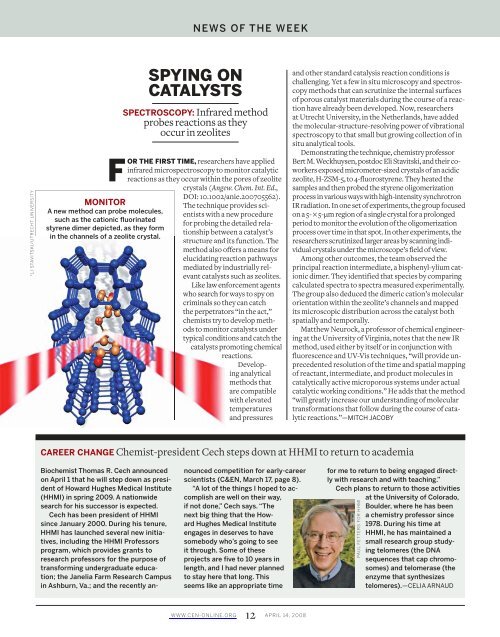Chemical & Engineering News Digital Edition - Institute of Materia ...
Chemical & Engineering News Digital Edition - Institute of Materia ...
Chemical & Engineering News Digital Edition - Institute of Materia ...
You also want an ePaper? Increase the reach of your titles
YUMPU automatically turns print PDFs into web optimized ePapers that Google loves.
ELI STAVITSKI/UT<br />
STAVITSKI/UTRECHT UNIVERSITY<br />
MONITOR<br />
A new method can probe molecules,<br />
such as the cationic fluorinated<br />
styrene dimer depicted, as they form<br />
in the channels <strong>of</strong> a zeolite crystal.<br />
Biochemist Thomas R. Cech announced<br />
on April 1 that he will step down as president<br />
<strong>of</strong> Howard Hughes Medical <strong>Institute</strong><br />
(HHMI) in spring 2009. A nationwide<br />
search for his successor is expected.<br />
Cech has been president <strong>of</strong> HHMI<br />
since January 2000. During his tenure,<br />
HHMI has launched several new initiatives,<br />
including the HHMI Pr<strong>of</strong>essors<br />
program, which provides grants to<br />
research pr<strong>of</strong>essors for the purpose <strong>of</strong><br />
transforming undergraduate education;<br />
the Janelia Farm Research Campus<br />
in Ashburn, Va.; and the recently an-<br />
NEWS OF THE WEEK<br />
SPYING ON<br />
CATALYSTS<br />
SPECTROSCOPY: Infrared method<br />
probes reactions as they<br />
occur in zeolites<br />
FOR THE FIRST TIME, researchers have applied<br />
infrared microspectroscopy to monitor catalytic<br />
reactions as they occur within the pores <strong>of</strong> zeolite<br />
crystals (Angew. Chem. Int. Ed.,<br />
DOI: 10.1002/anie.200705562).<br />
The technique provides scientists<br />
with a new procedure<br />
for probing the detailed rela-<br />
tionship between a catalyst’s<br />
structure and<br />
its function. The<br />
method also o<strong>of</strong>fers<br />
a means for<br />
elucidating reaction re pathways<br />
mediatedbyin<br />
mediated by industrially rel-<br />
evant evant catalysts catalyst such as zeolites.<br />
Like law en enforcement agents<br />
who searchfo<br />
search for ways to spy on<br />
criminals so th they can catch<br />
the perpetrators perpetrato “in the act,”<br />
chemists try to t develop meth-<br />
ods to monito monitor catalysts under<br />
typical condit conditions and catch the<br />
catalysts pr promoting chemical<br />
re reactions.<br />
Developing<br />
analytical<br />
methods that<br />
are compatible<br />
with elevated<br />
temperatures<br />
and pressures<br />
nounced competition for early-career<br />
scientists (C&EN, March 17, page 8).<br />
“A lot <strong>of</strong> the things I hoped to accomplish<br />
are well on their way,<br />
if not done,” Cech says. “The<br />
next big thing that the Howard<br />
Hughes Medical <strong>Institute</strong><br />
engages in deserves to have<br />
somebody who’s going to see<br />
it through. Some <strong>of</strong> these<br />
projects are five to 10 years in<br />
length, and I had never planned<br />
to stay here that long. This<br />
seems like an appropriate time<br />
WWW.CEN-ONLINE.ORG 12 APRIL 14, 2008<br />
and other standard catalysis reaction conditions is<br />
challenging. Yet a few in situ microscopy and spectroscopy<br />
methods that can scrutinize the internal surfaces<br />
<strong>of</strong> porous catalyst materials during the course <strong>of</strong> a reaction<br />
have already been developed. Now, researchers<br />
at Utrecht University, in the Netherlands, have added<br />
the molecular-structure-resolving power <strong>of</strong> vibrational<br />
spectroscopy to that small but growing collection <strong>of</strong> in<br />
situ analytical tools.<br />
Demonstrating the technique, chemistry pr<strong>of</strong>essor<br />
Bert M. Weckhuysen, postdoc Eli Stavitski, and their coworkers<br />
exposed micrometer-sized crystals <strong>of</strong> an acidic<br />
zeolite, H-ZSM-5, to 4-fluorostyrene. They heated the<br />
samples and then probed the styrene oligomerization<br />
process in various ways with high-intensity synchrotron<br />
IR radiation. In one set <strong>of</strong> experiments, the group focused<br />
on a 5- × 5-μm region <strong>of</strong> a single crystal for a prolonged<br />
period to monitor the evolution <strong>of</strong> the oligomerization<br />
process over time in that spot. In other experiments, the<br />
researchers scrutinized larger areas by scanning individual<br />
crystals under the microscope’s field <strong>of</strong> view.<br />
Among other outcomes, the team observed the<br />
principal reaction intermediate, a bisphenyl-ylium cationic<br />
dimer. They identified that species by comparing<br />
calculated spectra to spectra measured experimentally.<br />
The group also deduced the dimeric cation’s molecular<br />
orientation within the zeolite’s channels and mapped<br />
its microscopic distribution across the catalyst both<br />
spatially and temporally.<br />
Matthew Neurock, a pr<strong>of</strong>essor <strong>of</strong> chemical engineering<br />
at the University <strong>of</strong> Virginia, notes that the new IR<br />
method, used either by itself or in conjunction with<br />
fluorescence and UV-Vis techniques, “will provide unprecedented<br />
resolution <strong>of</strong> the time and spatial mapping<br />
<strong>of</strong> reactant, intermediate, and product molecules in<br />
catalytically active microporous systems under actual<br />
catalytic working conditions.” He adds that the method<br />
“will greatly increase our understanding <strong>of</strong> molecular<br />
transformations that follow during the course <strong>of</strong> catalytic<br />
reactions.”—MITCH JACOBY<br />
CAREER CHANGE Chemist-president Cech steps down at HHMI to return to academia<br />
for me to return to being engaged directly<br />
with research and with teaching.”<br />
Cech plans to return to those activities<br />
at the University <strong>of</strong> Colorado,<br />
Boulder, where he has been<br />
a chemistry pr<strong>of</strong>essor since<br />
1978. During his time at<br />
HHMI, he has maintained a<br />
small research group studying<br />
telomeres (the DNA<br />
sequences that cap chromosomes)<br />
and telomerase (the<br />
enzyme that synthesizes<br />
telomeres).—CELIA ARNAUD<br />
PAUL FETTERS FOR HHMI

















